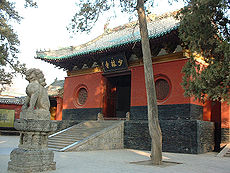- Nanquan
-
Nanquan (Chinese: 南拳; pinyin: Nán quán; literally "southern fist", or Chinese: 南派; pinyin: Nán pài; literally "southern school") refers to those Chinese martial arts that originated south of the Yangtze River of China, including Hung Kuen, Choi Lei Fut, Choy Ga, Lee Ga, Lau Ga, Mok Ga, Hak Fu Mun, Wuzuquan, Wing Chun, Etc.
Contemporary Wushu Nanquan
The contemporary Wushu event Nanquan is a modern style created in 1960 derived from martial arts derived in the Chinese provinces south of the Yangtze River and predominantly those styles popular in Guangdong, Guangxi, Fujian and Zhejiang. The basis of contemporary Nánquán hail primarily from traditional Cantonese family styles of Hong (Hung), Li (Lei), Liu (Lau), Mo (Mok) and Cai (Choi) along with their more contemporary Kung Fu variants of Choi Lei Fut, Hung Ga and Wing Chun.
Contemporary Nanquan features vigorous, athletic movements with very stable, low stances, extensive hand techniques and a vocal articulation called fasheng ("release shout") which is the predecessor of the Japanese and Korean martial arts kiai. Power is driven from sharp waist movement with special emphasis on fast stance transition to generate power and speed in the arms. Signature hand techniques of Nanquan are the consecutive downward strikes of the left and right fist called Gua Gai Quan (Gwa Kup Kuen; 挂盖拳), and consecutive upper cut while driving forward called Paoquan (Pow Kuen; 抛拳). There are relatively few kicks in Nanquan although the Tengkong Pantui Cepu (腾空盘腿度侧扑; "flying cross legs kick and land on the side") and Li Yu Da Ting (鲤鱼打挺直立; carp skip-up) are very common in advanced Nanquan routines. Nanquan also has its own contemporary weapons - the Southern Broadsword (Nandao; 南刀) and Southern Staff (Nangun; 南棍), which were included in the International Wushu competition in 1999.
In 2003, the International Wushu Federation (IWUF) changed the rules of contemporary Nanquan to make jumping techniques (难度) mandatory in Nanquan routines. Jump kicks spinning in mid-air between 360 and 720 degrees before touching the ground are now used in all Nanquan forms along with Stationary Back Flip (原地后空翻) and Single Step Back Tuck (单跳后空翻) for advanced competitors.
Chinese Boxing
Part of the series on
Chinese martial artsList of Chinese martial arts Terms Historical places - Shaolin Monastery (少林寺)
- Wudang Mountains (武當山)
- Mount Hua (華山)
- Mount Emei (峨嵋山)
- Kunlun Mountains (崑崙山)
Historical people - Five Elders (五祖)
- Yim Wing-chun / Yan Yongchun (嚴詠春)
- Hung Hei-gun / Hong Xiguan (洪熙官)
- Fong Sai-yuk / Fang Shiyu (方世玉)
- Dong Haichuan (董海川)
- Yang Lu-ch'an (楊露禪)
- Wu Quanyou (吳全佑)
- Ten Tigers of Canton (廣東十虎)
- Chen Fake (陳發科)
- Chan Heung / Chen Xiang (陳享)
- Wong Fei-hung / Huang Feihong (黃飛鴻)
- Sun Lu-t'ang (孫祿堂)
- Huo Yuanjia (霍元甲)
- Yip Man / Ye Wen (葉問)
- Wang Zi-Ping (王子平)
- Bruce Lee / Li Xiaolong (李小龍)
- Jackie Chan / Cheng Long (成龍)
- Sammo Hung / Hong Jinbao (洪金寶)
- Yuen Biao / Yuán Biāo (元彪)
- Jet Li / Li Lian Jie (李連杰)
- Donnie Yen / Zhēn Zǐdān (甄子丹)
Legendary figures - Bodhidharma / Putidamo / Damo (菩提達摩)
- Zhang Sanfeng (張三丰)
- Eight immortals (八仙)
Related Nanquan is also another form of Chinese boxing with a rather long history and a lot of schools and one of the more dynamic styles of Wushu. Nanquan is relatively popular in various parts of Guangdong Province, with each system having different styles and features from the others. To form this series of Chinese boxing, the essentials of the different postures of the various schools were systemized and summed up. As a result, a series of systematic and integrated United Nanquan has been created. It has very powerful and intense forms and tense postures which enable every part of the body to be fully toughened, so young people are very eager to learn this style. Practicing the various styles within the Nanquan system gives one great physical benefits.
See also
- Cai li fo
- Hung Kuen
- Northern and southern China
- Wing Chun
- Wushu (sport)
- Black Flag Wing Chun
Main Taolu Events Sparring Related Categories:- Contemporary wushu
- Chinese martial arts
Wikimedia Foundation. 2010.

